
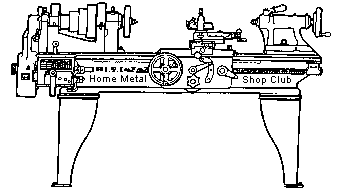
Volume 10, No 6 - Jun 2005
 |
 Volume 10, No 6 - Jun 2005 |
|
|
|
|
|
| President - |
Vice President - |
||
| Treasurer - |
Secretary - |
||
| Webmaster |
Editors - |
||
| Founder - |
SIG Coordinators - |
Statement of Purpose
Membership is open to all those interested in machining metal and tinkering with machines. The club provides a forum for the exchanging of ideas and information. This includes, to a large degree, education in the art of machine tools and practices. Our web site endeavors to bring into the public domain written information that the hobbyist can understand and use. This makes an organization such as this even more important.
June Program
Election of club officers will be held at the next meeting. If you want to run for an office, nominate yourself by raising your hand during meeting.
We have had a presentation each of the past eleven months. This month, the final of my tenure, does not have a planned program ---- yet. Two speakers had conflicting schedules. I am still trying to put something together.
It has been a pleasure working with the HMSC group. I've learned a lot and enjoyed every minute. For anyone interested in the office of vice president, I can at least provide information on two future speakers. One is an expert on compressed air. I was looking forward to his program and am disappointed he couldn't make this meeting.
All offices of HMSC are up for election. Dick Kostelnicek. has mentioned that he will step down as web master, so that job will need to be done as well. Dick has done a great job. Even though I am listed as a web master along with Dick, my contributions have been minimal when compared to his efforts. I will continue to assist in that job for the next web master, but if Dick won't tell you, I will. I really don't do much.
Thanks for a good year, Doug Chartier - HMSC Vice President
May Regular Meeting
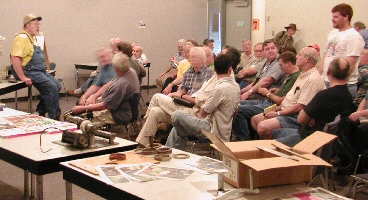 Collier Library, Houston Texas, May 14, 2005, 1:00 p.m., Doug
Chartier - Vice President presiding
Collier Library, Houston Texas, May 14, 2005, 1:00 p.m., Doug
Chartier - Vice President presiding
Business Meeting
Minutes are sent via email or regular mail to club members.
April Presentation
Doug Chartier lead a group discussion on turning tools and chip removal and efficiency.
Featured Article
Powder Coating in the Home Shop
George Carlson - HMSC Member
 Powder Coating is a fairly new technology that allows high
quality finishes to be applied to metal without the use of any solvents. The finish is so durable that it is
difficult to remove, even with a sandblaster.
Powder Coating is a fairly new technology that allows high
quality finishes to be applied to metal without the use of any solvents. The finish is so durable that it is
difficult to remove, even with a sandblaster.
The basic idea is to coat an object with a fine polymer powder, then place the object in an oven to cure the powder. While in the oven, the powder melts into a very thick syrup that flows over the surface, then cures to a hard surface.
The device in the photo is a Sensitive Drilling Jig I built about 16 years ago. It is used for fine drilling in conjunction with a large drill press or mill. The table on the jig's top raises the work under a bit held in the drill press chuck. I decided to use it as one of my first experiments with powder coating. The base was done in Blue, and then clear coated with a very glossy clear. It is almost like I poured glass over it. The frame was powder coated Chrome, then a translucent Candy Red was applied. This produces a Red with a very deep luster. The knob and top are single coats of White and High Gloss Black.
With the advent of low cost Powder Coating Guns and the
availability of small quantities of powder, Powder Coating in the home shop is
now possible. Details of the powder
coating process, and where to find materials, can be found in a
PDF article on the HMSC
web site Projects Page.
Welding Practices for the Home/Small Shop
George Carlson
- HMSC Member
Welding is inescapable; almost all metal assemblies have some type of welding used. It’s hard to imagine a home shop without the ability to do some types of welding. This article is intended to be an introduction to those welding procedures common in home shops. I may able be helpful for those of you who are thinking about buying some welding equipment, and need some ideas for you future acquisitions. I’m not going to try to teach welding in this short piece, there are plenty of books available on that subject. Just a little overview is all.
There are four primary types of welding done in the home shop. Oxy-Acetylene uses a burning mixture of gases to produce a flame hot enough to easily melt and join steel. The other processes are common in that they all use an electric arc as an energy source, but they are quite different in other ways. These are: Shielded Metal Arc Welding (Stick), Gas Metal Arc Welding (MIG), and Gas Tungsten Arc Welding (TIG).
Oxy-Acetylene
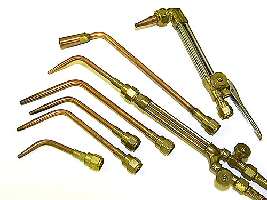 If
anyone ever asks me what type of welder he should buy as his first welder,
the question is easy to answer. I would say Oxy-Acetylene!
You probably would not get this answer from most commercial welders. That’s
because their use of welding is quite different from ours. Although
most commercial welders do not weld using gas, they use it for cutting, heating
and bending of metal. If you took
away their gas rig, they would be lost. Sometimes they forget that the Oxy rig
can weld too.
If
anyone ever asks me what type of welder he should buy as his first welder,
the question is easy to answer. I would say Oxy-Acetylene!
You probably would not get this answer from most commercial welders. That’s
because their use of welding is quite different from ours. Although
most commercial welders do not weld using gas, they use it for cutting, heating
and bending of metal. If you took
away their gas rig, they would be lost. Sometimes they forget that the Oxy rig
can weld too.
The Oxy-Acetylene rig can be used to weld steel and aluminum, as well as other materials. To switch between metals is as simple as switching filler rod and flux (if needed). It can be used to Braze and Silver Solder. A cutting torch can cut through very thick sections of steel. And by using either a regular tip, or a special “Rose-Bud” tip, you can pre-heat, heat treat, and temper carbon steel. The same equipment is invaluable for heating metal for bending. There is little that can be done with other welding equipment that cannot be done with a torch and some practice. Oxy-Acetylene is completely portable. You will never need to find a place to plug it in.
I guess I am a little partial to the torch for another reason. I started welding at 14 with the help of my best-friend’s father. He was a precision welder for the tool & die shop at a Fischer Body plant. The only equipment he had at home was a simple oxy rig, but the man could do wonders with that torch. I watched him re-build the broken fins on motorcycle heads. He would stack the beads of Aluminum, one on top of the other, until they reached the proper height. Then, with a little shaping with the file, the head looked like new. Another time I saw him repair a broken crankshaft from a racing boat. The crank must have had a flaw in the original casting (or forging) because it had broken across a fairly thick section. It would have been nearly impossible to weld because so much metal would have had to be removed to make a “V” for the weld penetration to be deep enough. And the welding heat surely would have warped the crank so badly that it my not have been usable. Instead, he choose to Silver Solder the crank together! Silver Solder? Yes, it turns out the high grade Silver Solder, such as Stay-Silv 45, has a tensile strength of about 45000 psi. About half of what weld metal has. But since he was able to flow the Silver Solder in the joint and completely join the thick section, the crank was much stronger than if he had ground a “V” and welded it.
When you buy your torch and regulators, get a good brand name such as Victor. This will make it much easier to get add-on accessories later. The regulators are the key. Cheap regulators make noise, do not provide a well controlled flow of gas, and can actually pulse the gas and make your torch behave in strange ways. The best size tanks to start out with are about 80 cu. ft. These are called “Q” for the Oxygen and “WQ” for the acetylene. Smaller tanks mean more trips to the welding supply, larger tanks get hard to handle.
I always like to see what kind of controls a particular machine has available. The theory is that the larger the number of controls, the more complex the machine is, but the more control the operator has over it. The controls for an oxy-acetylene rig are pretty much limited to tip selection, two gas pressures, and the valves on the torch. Ideally the valves on the torch are operated as on/off and the gas flow is controlled by the regulators.
Safety equipment is fairly simple. Eye protection in the form of gas welding goggles is important. Gas welding does not produce UV, so eyes mainly have to be protected from debris. Since I wear glasses, I prefer the use of a full-face shield made of green poly carbonate. It works great for most work I do with the torch. Gloves are important, I like to use the gloves designed for TIG welding. They are lightweight, but still help protect you fingers from hot metal. For the most part gas welding and brazing is clean. Cutting is another story. When cutting, a lot of very hot sparks are produced. Be sure to work well away from any flammable objects.
Stick Welding
After you have your Oxy-Acetylene rig, you may have a need for welding thick sections of steel. This is the sort of thing that is really hard to do with an oxy-torch, but easy to do with an arc welder. The official name for stick welding is Shielded Metal Arc Welding, or SMAW. If you look at a typical SMAW electrode, you will notice a steel rod with a covering on it. (Like a corn dog only skinnier.) Instead of corn bread, the steel is coated with a material that does several things. First, it acts as an insulator that assures only the tip of the rod will make electrical contact. As the material burns, it produces gasses that shield the weld puddle from the air. It also contains minerals that cleanse the molten metal and float impurities to the surface. And lastly in provides a cover to protect the weld as it cools. If you lay your weld down nicely, the slag (what the shielding material turns into) can be easily chipped off the weld. If the weld is not going well, the slag can find itself mixed with the filler metal. These “slag inclusions” can weaken the weld and cause corrosion.
SMAW is great for welding steel. In industrial environments it can be used for welding other metals, and gouging out “V’s” in metal for future welding, but for the home shop it is pretty much a single use device.
Machines are available with AC only and AD/DC use. AC/DC machines can give you more versatility, but for general welding an AC “Cracker Box” welder works well and is very affordable.
If you look at a typical AC welder, about the only control available is the current. Sometimes this is a sector switch, sometimes is more analog. On the AC/DC welders, there is a switch that allows selection of AC, DC+, and DC-. DC- is called straight polarity, DC+ is called reverse polarity.
SMAW can be messy. Sparks fly and a lot of smoke is generated. Be sure to do this in a well-ventilated area where there is plenty of room for the sparks to fly without catching something on fire. Wear heavy welding gloves, a welding jacket or heavy shirt buttoned up, and a welding helmet with a #11 shade. Electronic helmets are great, more about them later.
MIG Welding
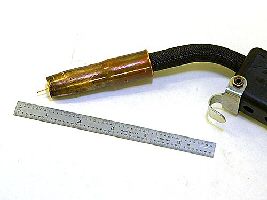 MIG, or wire welding, also has a fancy name. Officially it is called Gas Metal Arc
Welding or GMAW. MIG stands for Metal
Inert Gas, which tells the story a bit better.
There are actually two types of MIG welding. The old school uses a bare wire electrode surrounded by a
shielding gas such as Carbon Dioxide (CO2).
The other method does not use the gas, but instead uses a special
electrode wire with a flux core. This
is like a SMAW electrode turned inside out.
MIG, or wire welding, also has a fancy name. Officially it is called Gas Metal Arc
Welding or GMAW. MIG stands for Metal
Inert Gas, which tells the story a bit better.
There are actually two types of MIG welding. The old school uses a bare wire electrode surrounded by a
shielding gas such as Carbon Dioxide (CO2).
The other method does not use the gas, but instead uses a special
electrode wire with a flux core. This
is like a SMAW electrode turned inside out.
MIG welding is fast! Inside the machine is a large spool of wire. The wire is the filler rod. During welding the wire taken from the spool and driven though a liner in the welding cable and emerges from the welding nozzle. As long as the wire can be supplied, you can keep welding.
The most common electrode (wire) to use is probably ER70S6 in 0.035” diameter. The shielding gas can be either pure CO2 or a CO2/Argon mixture called C25. If you need to make deep and heavy welds, pure CO2 is what you need. For most work, however, C25 gives you much better control.
The flux-cored MIG wire was developed for heavy industrial use. Shielding gases can get blown away in outdoor welding such as in shipyards. The flux within the wire produces a slag that protects the weld as it cools. A few years ago, small gauge flux cored wire came on the market. It has the advantage of not requiring shielding gas, valves, tanks, and regulators. The super cheap MIG machines are almost always Flux Core only machines. I haven’t used one, but I have not run into anyone who has nice things to say about flux-core MIG, so buyer beware.
Solid core MIG produces a little smoke. Most of the smoke comes from the waxy substance used to keep weld spatter from sticking to the nozzle (spray Pam works well by the way). There can be quite a bit of sparks and spatter. With flux-core MIG, there is a lot of smoke, sparks, and spatter. So keep the weld area clear of flammables.
Welding Stainless Steel and Aluminum can be done with MIG, but changing between metal types takes quite a bit of effort. The spool inside the machine and the liner for the MIG gun must be changed when changing material. Aluminum is usually welded with a “spool gun”. The spool gun takes the place of the normal MIG gun. Instead of using a spool of wire inside the machine, the spool gun has a small spool of wire on the gun. Aluminum wire is soft, and putting the spool and wire feeder on the gun instead of in the machine makes pushing the fragile wire through a long cable unnecessary. The bad news is the spool guns are very expensive and require special controllers in the MIG machine.
Most MIG machines have only two controls. There will be a control for the wire feed rate and one for the voltage control. There is usually a chart on the machine that gives you starting values for each of the controls for various thickness of material.
Safety wise, it’s almost the same as stick welding. Good gloves, jacket, and a #11 shade works well.
There are quite a few small MIG machines out that are made for operation at 115VAC. Although this sound good, they can be quite difficult to operate. The larger machines are more forgiving when you are have a hard time getting the arc right. MIG is a constant voltage operation. The welder supplies all the current it can to keep the voltage constant at the arc. The small 115VAC machines just don’t have much current available, so the welding wire can stick to the work and the machine overloads. You then have to stop the machine, cut off the wire, then start again. My 250A Hobart Beta-MIG has never stuck a wire.
TIG Welding
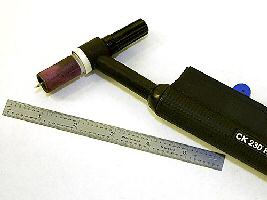
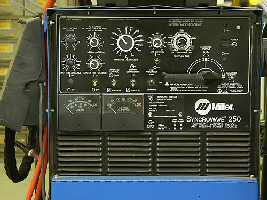 Tungsten Inert Gas, Gas Tungsten Arc Welding (GTAW),
Heli-Arc, or whatever you wish to call it, is the high-tech way to weld. TIG
gives the welder the control of oxy-acetylene with the speed and power of electric
arc. Almost any metal that can be welded can be
welded with TIG.
Tungsten Inert Gas, Gas Tungsten Arc Welding (GTAW),
Heli-Arc, or whatever you wish to call it, is the high-tech way to weld. TIG
gives the welder the control of oxy-acetylene with the speed and power of electric
arc. Almost any metal that can be welded can be
welded with TIG.
TIG uses a non-consumable Tungsten electrode to provide an electric arc between the electrode and the work piece. A shielding gas, usually Argon, surrounds the Tungsten and the weld puddle to protect the weld area from air. A filler rod is fed into the puddle by hand, much like oxy-acetylene welding. Better TIG machines have foot or hand controls that allow the welder to adjust the welding current while in the process of welding. This give the welder complete control over the weld puddle and makes welding pieces that are delicate, or variable in thickness, relatively easy.
There are two basic set-ups for TIG welding. One set-up is for Steel, Stainless, Copper and most other metals. The other set-up is for Aluminum. The only difference between the set-ups is the type and shape of the electrode, and the whether DC or AC is used.
Steel is welded with a very sharp Tungsten and DC current. The Tungsten used is generally 2% Thoriated. The Thorium makes the arc easier to start and helps preserve the fragile point on the Tungsten. To avoid having to touch the base metal with the Tungsten to start an arc, a very high frequency / high voltage is used instead. The high frequency is only used to start the arc since, with DC current, the arc will continue once it is started. Since the Tungsten is at a negative potential, it sprays the work piece with electrons. This causes an extremely high heat to be concentrated in a very small area. With a little practice 0.020” or ½” steel can be easily welded. All that changes is the current setting.
To weld Aluminum AC current is used, and the high frequency is set to continuous. Although this is less efficient than DC, the reverse polarity mode half of the cycle (electrode positive) cleans the base metal and improves the weld. Since Thorium can contaminate Aluminum and Magnesium, pure tungsten is usually used as the electrode material. The tip of the electrode is also different. Since the AC current causes a lot of heating in the Tungsten, the tip of the electrode is allowed to form into a ball. The more expensive TIG machines allow control of the waveform so that the cleaning part of the cycle can be reduced and the electrode kept sharper for a finer bead.
Cleanliness is very important in TIG welding. There is no flux to carry off contaminates, so the metal should be very clean before you start welding. For this same reason, there is almost no trace of smoke while welding. I routinely TIG weld in the shop with the doors closed and the air-conditioner on. I find TIG welding steel peaceful and relaxing. There is almost no noise, just a little sizzle. Aluminum welding is similar, but the AC current does cause a strong hum, but not as bad as most other welding methods.
Depending on the TIG machine, the unit can have quite an array of knobs and switches. Most TIG machines will have a control for current, and a switch for selecting AC, DC+, and DC-. They will generally have a switch that allows you to select high frequency at start-up or continuous. Other controls will have to do with the timing of the gas flow and tapering of the current to improve the end of a weld. Some TIG machines even have controls that allow you to run in a pulse mode. The pulse mode allows the current to rise and fall quickly. This causes the weld puddle to melt then freeze as you move along. With this technique you can weld very thin metals without burning through. Have any beer cans you need to repair?
Since spatter is not a problem with TIG, you can use lighter gloves. The most popular gloves are the white TIG gloves. They give good protection, but are thin enough to feel the TIG torch and filler rod. Use a #11 shade for steel. For Aluminum, a #13 is a better choice. Aluminum is very good reflector and therefore a bit brighter.
A neat accessory for TIG welding is the water cooler. Some torches are designed to be water cooled, and contrary to what you might think, these torches are much smaller and lighter than the air-cooled variety. My 300 Amp water-cooled torch is about half the weight of my 175 Amp air cooled torch.
Pure Argon is the gas normally used. Helium used to be popular, but it is now used only for special welding techniques. I use a 122cu. ft. bottle. Gas is usually consumed at a rate of 20cu. ft./hour, so you can judge for yourself what size bottle to get.
In the past few years, inverter type TIG welders have come on the market. These welders can be built small and light because they replace the giant transformer with electronic circuitry that allows the use of a very small transformer to do the same job. The thing to remember is that these machines are DC only. Since AC welding is not possible, welding of Aluminum is not practical. But if you only need to weld steel, these machines are very nice. The better units from Miller and Lincoln have very fine control of the current, and some other new features that make complex jobs easier to do.
Since TIG uses constant current, the same as SMAW, most TIG machines can also be used as a high quality stick welder. Also, using a HF converter with a standard SMAW machine can allow you to do TIG. But you will not have the fine (and remote) control of welding current.
Electronic Helmets
I have a Jackson electronic helmet, and I think it’s great. This is the second electronic helmet I bought. The other helmet meant an early demise after I dropped it and broke the LCD window. So be careful with that expensive helmet, they can get broken. One really nice thing about electronic helmets is that most of better ones have a variable filter. So if you need to change from #11 to #13, just turn the dial.
Summary
Oxy-Acetylene –
Stick –
MIG (Gas shielded) –
MIG (Flux core) –
TIG –
My favorite welding technique is TIG. If the project large, like the material rack I recently built, I use the MIG. TIG produces showroom quality welds. Because of the foot pedal control, I can adjust the weld current while I’m welding. So even if I haven’t done any welding in months, I can turn on the TIG machine and be confident that the weld will come out beautiful on the first try.
References
|
Visit Our Home Page at |
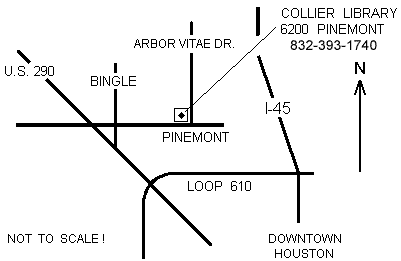 |
Right
click below then select [Save Target As..]
From Netscape select [Save Link As..]
Microsoft
Word version of this newsletter 234 KB
